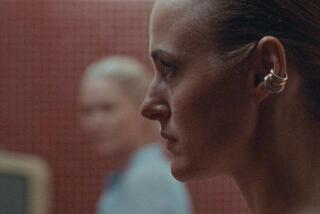Review: ‘He Named Me Malala’ is a moving portrait of a Nobel-winning woman
- Share via
Moviegoers hankering for a female superhero film needn’t wait for “Wonder Woman.” A big screen heroine of astounding power swoops into theaters this week, caped in a hijab, a backpack full of books slung over her shoulder, a crooked smile the reminder of her fearlessness.
Davis Guggenheim’s documentary “He Named Me Malala” is the origin story of 18-year-old Nobel Peace Prize winner Malala Yousafzai, who stood up for girls’ education in her native Pakistan and was shot in the head for her efforts by the Taliban.
Both an intimate portrait of the young activist and a sweeping antidote for cynicism, the inspiring story toggles between poignant footage of Malala today, acclimating to life in Birmingham, England, with her endearingly normal family, and dream-like animated flashbacks of their existence in Pakistan’s Swat Valley.
Told with enough sensitivity for children and enough sophistication for adults, “He Named Me Malala” is the rare documentary that plays as a family film. In a contemporary entertainment world devoted largely to antiheroes, it is a kind of balm to watch a protagonist who is, unequivocally, doing the right thing. That she is a real-life teenage girl, a bookish Pakistani sister to Katniss Everdeen, is yet another welcome gift.
SIGN UP for the free Indie Focus movies newsletter >>
While the subject is deeply moving — and bringing tissues is recommended — Guggenheim’s treatment is restrained, as he deploys inventive storytelling techniques that invite viewers inside Malala’s world, to feel her joy, trauma and ultimately forgiveness.
The film’s producers, Walter Parkes and Laurie MacDonald, are known for smart narrative features like “Gladiator” and “Catch Me if You Can,” and set out to make another such film based on early sample pages they read from Malala’s 2013 autobiography. But upon meeting the teenager, they determined that such a singular, charismatic figure would be impossible to cast and decided to make the movie a documentary.
Thank goodness they did, as their young star holds the screen with uncommon presence and moral authority. Taking a microphone to address an audience at the United Nations after recovering from the injuries that left her with hearing loss and paralysis on the left side of her face, Malala might as well be John Wayne walking into a saloon: Whatever happens next, we’re on her side.
The story begins with Malala’s father Ziauddin’s decision to name his daughter after an Afghani Pashtun female warrior who was killed for speaking out in the 19th century — and this is almost as much his film as hers. If he burdened his child with a sense of destiny by doing so, Ziauddin also armed her with love and self-possession.
Some of the movie’s most affecting scenes are its everyday images of modern fatherhood — Ziauddin frying eggs and making tea for his family, Malala teaching her dad how to tweet. In his gentleness, Ziauddin provides a stunning contrast to the images of warfare and terrorism from that part of the world with which most Americans are familiar.
Guggenheim, who previously directed the Academy Award-winning Al Gore climate change documentary, “An Inconvenient Truth,” and the public education expose “Waiting for Superman,” has a knack for finding the human moments in a politically or scientifically complex subject. This time he’s made a movie composed almost entirely of such moments, and they reveal the duality of Malala’s life.
With footage of her Googling a handsome cricket player or frowning over a disappointing physics grade, Guggenheim allows us to get to know a shy teenage girl coming of age. But when his cameras follow Malala as she grills the president of Nigeria about the status of schoolgirls abducted by Boko Haram or challenges President Obama on the use of drones, he shows us Malala as a public figure of remarkable courage and poise.
In order to depict Malala’s life before she was airlifted to England for medical care, Guggenheim made the unconventional decision to rely primarily on impressionistic, hand-drawn animation designed by Jason Carpenter. The marvelous effect is to take us inside Malala’s head, so that we might see the Swat Valley as she saw it as a child, its bucolic rivers and mountains, its happy schoolgirls in colorful dresses, its dirty streets.
A stirring score by composer Thomas Newman underpins the drama. At times the music almost seems unnecessary, as the lilt of Malala’s accented English does such an effective job of evoking emotion.
One of the most delightful animated sequences is of Ziauddin as a child, being bullied for his stammer, his attempts at speech illustrated first as halting little lines, and then, when he finally finds his voice, as lovely swirls and flames that dance and travel on the breeze. It’s an artful way to communicate what ultimately becomes the family’s superpower — their willingness to speak when others are silent.
Follow me on Twitter @ThatRebecca
------------
‘He Named Me Malala’
MPAA rating: PG-13, for thematic elements involving disturbing images and threats
Running time: 1 hour, 27 minutes
Playing: ArcLight, Hollywood; Landmark, West L.A.
More to Read
Only good movies
Get the Indie Focus newsletter, Mark Olsen's weekly guide to the world of cinema.
You may occasionally receive promotional content from the Los Angeles Times.











